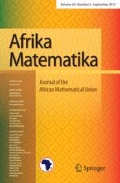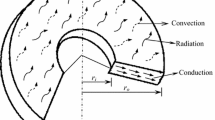Abstract
Here, the optimal homotopy asymptotic method (OHAM), one of the newest analytical methods which is powerful and easy-to-use, is applied to solve heat transfer problems with high nonlinearity order. In this research, the OHAM is used to investigate two problems: the temperature distribution equation in a convective straight fin with temperature-dependent thermal conductivity and the convective–radiative cooling of a lumped system with variable specific heat. The validity of our results is verified by numerical results. The OHAM provides us with a convenient way to control the convergence of approximation series and adjust convergence regions when necessary. This realizes using a number of auxiliary constants which are optimally determined. Thus, unlike perturbation methods, the OHAM does not depend on any small physical parameters and it is valid for both weakly and strongly nonlinear problems. It has been attempted to show the capabilities and wide-range applications of the OHAM in comparison with the previous methods in solving heat transfer problems.
Similar content being viewed by others
Abbreviations
- A :
-
Area (m2)
- A c :
-
Cross-sectional area of fin (m2)
- b :
-
Fin length (m)
- c :
-
Specific heat (J kg−1 K−1)
- c a :
-
Specific heat at ambient temperature (J kg−1 K−1)
- E :
-
Surface emissivity (W)
- h :
-
Convection heat transfer coefficient (W m−2 K−1)
- k :
-
Thermal conductivity of fin material (W m−1 K−1)
- k a :
-
Thermal conductivity at ambient temperature (W m−1 K−1)
- k b :
-
Thermal conductivity at base temperature (W m−1 K−1)
- P :
-
Fin perimeter (m)
- T :
-
Temperature (K)
- T a :
-
Ambient temperature (K)
- T b :
-
Base temperature of fin (K)
- Ti :
-
Initial temperature (K)
- T s :
-
Effective sink temperature (K)
- V :
-
Volume (m3)
- x :
-
Distance measured from fin tip (m)
- β :
-
Volumetric thermal expansion coefficient (K−1)
- θ :
-
Dimensionless temperature (–)
- λ :
-
Slope of thermal conductivity-temperature curve (K−1)
- ξ :
-
Dimensionless length (–)
- ρ :
-
Density (kg m−3)
- σ :
-
Stefan–Boltzman constant (–)
- τ :
-
Dimensionless time (–)
- ψ :
-
Thermo-geometric fin parameter (–)
References
Aziz A., Na T.Y.: Perturbation Method in Heat Transfer. Hemisphere Publishing Corporation, Washington (1984)
Nayfeh AH.: Introduction to Perturbation Techniques. Wiley, New York (1979)
Rand R.H., Armbruster D.: Perturbation Methods, Bifurcation Theory and Computer Algebraic. Springer, Berlin (1987)
He, J.H.: Non-perturbative methods for strongly nonlinear problems. Dissertation, de-Verlag im Internet GmbH, Berlin (2006)
Bildik N., Konuralp A.: The use of variational iteration method, differential transform method and adomian decomposition method for solving different types of nonlinear partial differential equations. Int. J. Nonlinear Sci. Numer. Simul. 7, 65–70 (2006)
Lyapunov A.M.: General Problem on Stability of Motion (English translation). Taylor and Francis, London (1992)
Karmishin A.V., Zhukov A.I., Kolosov V.G.: Methods of Dynamics Calculation and Testing for Thin-Walled Structures. Mashinostroyenie, Moscow (1990)
Adomian G.: Solving Frontier Problems of Physics: The Decomposition Method. Kluwer, Dordrecht (1994)
Liao, S.J.: The proposed homotopy analysis technique for the solution of nonlinear problems. Ph.D. Thesis, Shanghai Jiao Tong University (1992)
Liao S.J.: Beyond Perturbation: Introduction to the Homotopy Analysis Method. Chapman and Hall/CRC Press, Boca Raton (2003)
Liao S.J.: On the homotopy analysis method for nonlinear problems. Appl. Math. Comput. 147, 499–513 (2004)
He J.H.: Variational iteration method for autonomous ordinary differential systems. Appl. Math. Comput. 114(2–3), 115–123 (2000)
Marinca V., Herişanu N., Nemeş I.: Optimal homotopy asymptotic method with application to thin film flow. Cent. Eur. J. Phys. 6, 648–653 (2008)
Marinca V., Herişanu N.: Application of optimal homotopy asymptotic method for solving nonlinear equations arising in heat transfer. Int. Commun. Heat Mass Transf. 35, 710–715 (2008)
Marinca V., Herişanu N., Bota C., Marinca B.: Optimal homotopy asymptotic method to the steady flow of a fourth grade fluid past a porous plate. Appl. Math. Lett. 22, 245–251 (2009)
Herişanu N., Marinca V., Dordea T., Madescu G.: A new analytical approach to nonlinear vibration of an electric machine. Proc. Romanian Acad. Ser. A 9(3), 229–236 (2008)
Marinca V., Herişanu N.: Determination of periodic solutions for the motion of a particle on a rotating parabola by means of the optimal homotopy asymptotic method. J. Sound Vib. 359, 1450–1459 (2010)
He J.H.: A coupling method for homotopy technique and perturbation technique for nonlinear problem. Int. J. NonLinear Mech. 35, 37–43 (2000)
He J.H.: Asymptotology by homotopy perturbation method. Appl. Math. Comput. 156, 591–596 (2004)
He J.H.: Homotopy perturbation method for solving boundary problems. Phys. Lett. A 350, 87–88 (2006)
Kern D.Q., Kraus D.A.: Extended Surface Heat Transfer. McGraw-Hill, New York (1972)
Aziz A., Enamul Hug S.M.: Perturbation solution for convecting fin with variable thermal conductivity. J. Heat Transf. 97, 300–310 (1975)
Razelos P., Imre K.: The optimum dimension of circular fins with variable thermal parameters. J. Heat Transf. 102, 420–425 (1980)
Laor K., Kalman H.: Performance and optimum dimensions of different cooling fins with a temperature-dependent heat transfer coefficient. Int. J. Heat Mass Transf. 39, 1993–2003 (1996)
Yu L.T., Chen C.K.: Optimization of circular fins with variable thermal parameters. J. Franklin Inst. B 336, 77–95 (1999)
Incropera F.P., Dewitt D.P.: Introduction to Heat Transfer, 3rd edn, pp. 114. Wiley, New York (1996)
Herisanu N., Marinca V.: Accurate analytical solutions to oscillators with discontinuities and fractional-power restoring force by means of the optimal homotopy asymptotic method. Comput. Math. Appl. 60, 1607–1615 (2010)
Author information
Authors and Affiliations
Corresponding author
Rights and permissions
About this article
Cite this article
Dinarvand, S., Hosseini, R. Optimal homotopy asymptotic method for convective–radiative cooling of a lumped system, and convective straight fin with temperature-dependent thermal conductivity. Afr. Mat. 24, 103–116 (2013). https://doi.org/10.1007/s13370-011-0043-9
Received:
Accepted:
Published:
Issue Date:
DOI: https://doi.org/10.1007/s13370-011-0043-9
Keywords
- Nonlinear heat transfer equations
- Extended surface
- Convective–radiative cooling
- Temperature-dependent thermal conductivity
- Optimal homotopy asymptotic method (OHAM)
- Homotopy perturbation method (HPM)



